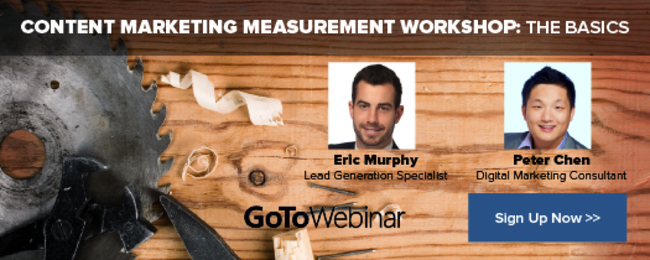
According to the Content Marketing Institute’s 2015 B2B and B2C benchmark reports, less than a quarter of marketers are able to prove content marketing ROI. Measurement is a key area of difficulty: 49% of B2B and 51% of B2C marketers were challenged with measuring content effectiveness in 2014.
While definitions of effectiveness may vary by team, it should at least be simple to figure out if you’re successful once you define what “success” means. Here are two simple steps to establish a baseline for content effectiveness and prove if it’s failing (or not).
Step 1: Understand the Different Types of Content Metrics
Not all content is created equal, and appropriate metrics fluctuate depending on a wide range of variables. Jay Baer’s Field Guide to the 4 Types of Content Marketing Metrics outlines the four types of content metrics that are used to calculate effectiveness.
1) Consumption Metrics
Consumption metrics are the most basic of the four. Content views (page, video, SlideShare, etc.), time on page, and bounce rate can all be accessed easily from an analytics tool, like the one found in HubSpot.
These simple data points tell the surface level story of content performance and serve as measurements of brand awareness and web traffic.
2) Sharing Metrics
Sharing metrics can be used to unveil more information about reach, awareness, resonance, and engagement. Likes, shares, tweets, retweets, +1s, and pins all speak to content’s success across social channels. Forwards indicate resonance via email, and inbound links serve as additional validation across the web.
3) Lead Generation Metrics
Lead generation metrics like form submissions, email /blog subscriptions, and conversion rates speak directly to the value consumers place in your content.
If access to your content is worth disclosure of personal information, then you’ve earned the right to gather that information for segmentation and targeting. Beware, however, that form submissions do not necessarily imply a desire to do business with you.
4) Sales Metrics
Sales metrics show how content impacts customer acquisition and adds to top-line growth. Revenue, of course, is the ultimate goal of marketing, but content attribution can be a tough nut to crack, especially given that most customers require 7+ touch points prior to making a buying decision.
Be sure to track assists alongside conversions in order to understand which content is most effective at influencing buying behavior, directly or indirectly.
Step 2: Map those Metrics to the Purchase Funnel
The concept of the purchase funnel (commonly referred to as the Buyer’s Journey) has been around since the late 19th century and still holds water to this day, even in the digital landscape. It represents the stages customers go through when making a purchasing decision.

When mapping metrics to each stage of the purchase funnel, there are two primary considerations that marketers should take into account: purpose of the content and consumption barriers.
Awareness
At the Awareness phase of the buyer’s journey, your goal should be to entertain or educate a prospect. Content used to generate awareness should be helpful and unbiased—you’re not trying to sell anything at this point. Instead, your goal should be to deliver problem solving content that’s helpful. Consumption barriers should be low; that is, prospects shouldn’t have to make significant sacrifices like time, privacy, or money to experience your content.
Typical content that resides in the Awareness phase includes blog posts, press releases, web pages, videos, and free whitepapers, guides, and ebooks. The corresponding metrics used to measure content effectiveness in the Awareness phase should be primarily consumption and sharing metrics, but lead generation metrics should be used in addition if any of the above listed assets are gated behind forms.
Interest & Desire
In the Interest and Desire phases of the buyer’s journey, your goal should be to persuade prospects into seeing your products or services as solutions to their particular problems. Content in this phase should be more biased towards your company, displaying factors that differentiate you from your competitors in your ability to solve said problems. Consumption barriers should be somewhat higher than at the Awareness phase—if prospects are genuinely interested in your solution, they will be willing to sacrifice more time and privacy to see how you can really help them.
Webinars, case studies, brochures, catalogs, FAQs, and spec sheets are all examples of content that helps generate interest and converts that interest into desire. Lead generation metrics should be used to measure effectiveness in this phase, but also be sure to track conversion assists in order tie these assets into sales metrics down the road.
Action
At the Desire phase of the buyer’s journey, prospects have done their research and already know that they want to do business with you or a competitor. Your goal should be to qualify them and convince the right people to choose you. Content in this phase should be heavily biased towards your branded solution and clearly express the value it provides for customers.
Consumption barriers should be high; this is where you begin asking for one-on-one time over the phone or face-to-face. Content should ensure that privacy barriers are taken down and the prospect will show you his or her hand. Free trials, live demos, assessments, consultations, coupons, and estimates are all example of content that are used to generate action. Sales metrics should be the primary dimensions for measuring effectiveness of content in this phase.
Taking Measurement to the Next Level
All content initiatives should be tied to revenue, but that’s not easy to do. Attribution modeling can be tricky, especially when looking at a multitude of unequal touch points, micro conversions, and conversion assists. But the first step to proving content ROI is simply nailing down the fundamentals of metrics—specifically, which to measure and when.
Join me for my Content Marketing Measurement Workshop on Thursday, January 29th to dive deeper into the basics and work towards proving that your content is succeeding, not failing.
![]()


